It happens that if you need to install Windows 10, you don’t find a flash drive of the right size at hand, and the drive has outlived its own and has not been used for a long time, so installing “dozens” from the drive is unrealistic. In this case, the installation method will come to the rescue operating system from hard drive. Yes, one of the hard disk partitions will serve as a boot device with Windows 10 distributions.
What is needed
To install Windows 10 from another HDD or partition successfully, the following tools are needed:
- management program windows bootloader (we will use EasyBCD with a graphical interface);
- utility for unpacking the image;
- a free partition on a hard drive with a volume of at least 4-5 GB (for recording installation files);
- An ISO image of a satisfactory edition or build of Windows 10.
Preparation for installation
In principle, installing dozens from the hard drive is the same as installing the preceding Microsoft OS. Let's see how this is done using the EasyBCD utility and Daemon Tools as an example.
We will use Deamon Tools only for copying the contents of the image to disk, which any archiver or file manager does well, so if you do not use this program, it makes no sense to install it. Its functionality in our case will completely replace 7Z or Total Commander.
Many users recommend creating a new partition (or biting about 8-10 GB of free space from the existing one) to write installation files to it, in order to protect itself from losing important information stored on the boot partition. So let's do it, implying that you do not have a small free partition created to install dozens from your hard drive.
- We go to the "Management" using the context menu of the "My Computer" folder.
- Go to the "Disk Management" section.
- We select the section from which we need to cut off a little unallocated space to create a new one, call its context menu and click “Compress Volume”.

- Enter the size by which we will compress the space, and click "Compress".
This volume will be used to form a new partition, onto which we will later copy the Windows 10 installation distribution kit. Therefore, the size should at least 15% exceed the image size.

- Create a “Simple Volume” in place of the unallocated area, calling its context menu.
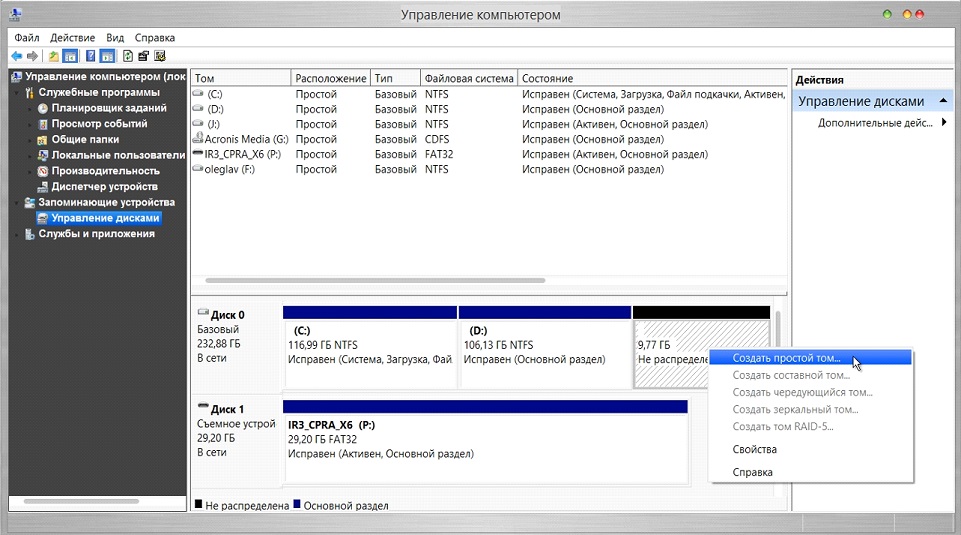
- Specify the volume label, its file system (preferably NTFS), the standard cluster size, and click Finish.
- Now copy the contents of the ISO image to the newly created section. This can be done by unpacking the ISO using the archiver or, for example, through Daemon Tools.
- Launch DT and add ISO to its window with windows distribution 10 by dragging its icon or using the “Add” button.
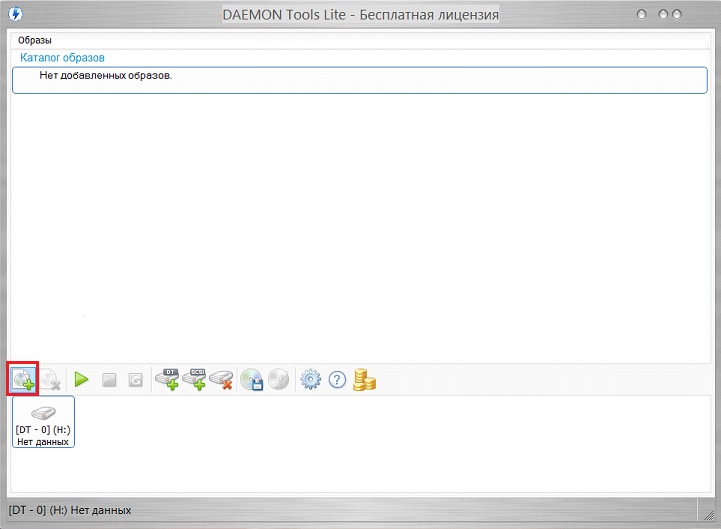
- Select the added document and click "Mount."

- We copy all the contents of the disk mounted in the virtual drive to the new partition of the newly created hard disk only.
It remains to create a new boot record to start the computer using the unpacked image as bootable media.
- Launch EasyBCD and click on the “Add Record” button located on the left side of the interface.
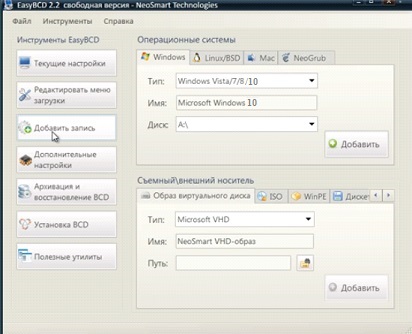
- In the "Removable / external storage»Go to the" WinPE "tab and set a name similar to the name of the created partition.
- We click on the icon with three dots, located to the right of the "Path" form, and specify the file "boot.wim" located in the "sources" directory.

- Click "Add."
This action will add a new item to the list of bootable operating systems, the name of which is specified in the "Name" form.
To be sure, click "Current Settings" and check if a new boot entry has been added to the Windows bootloader.
Installation of "tens"
- We restart the computer.
- We select the second option to start the PC from the hard drive, and press "Enter".
And repeat the above hundreds of times, we will not. On this today's goal is achieved.
(Visited 6,621 times, 4 visits today)
Many of those who have experienced installing or reinstalling Windows systems know that in most cases they are used to perform this operation external media like or USB drives. If you try to run the installation file from the hard drive, the user will not get the desired result. Therefore, for Windows 7, installation from a hard disk should be performed using completely different methods. For the average user, there are five main options that we will discuss now.
Windows 7: installation from the hard drive. Installation options
So, we will consider some directions in the installation of the seventh version of the system. Among the main options are the following:
- installation on top of the old "seven";
- installation as a second OS;
- installation using command line;
- use of special utilities;
- installing the system on an external HDD.
Each of these methods has its advantages and disadvantages, however, for all of them, one common rule is to have an image of the installation distribution of the system, which you will have to work with later. In addition, if the computer already has hard sections drive, when installing Windows 7, you can not touch them. Otherwise, they will need to be created. But more on that later.
Preliminary information
Now let's look at some initial conditions, which, if necessary, must be observed without fail.
The system requirements are such that a system with 32-bit architecture requires at least 16 GB of free disk space, and for the x64 system - about 20 GB. And this provided that there are already installed systemthe directory of which after installation will be renamed to Windows.old. You can’t delete it manually by any means (unless you do a disk cleanup). Then it will just be impossible to roll back.
Installation on top of an old system
Using this technique, you immediately need to understand what to format hDD installing Windows 7 will fail, even if it is a system partition. But we will rely on the fact that the distribution is located on drive C when the partition is done. How to partition a disk will be discussed later.
As already understood, the downloaded distribution kit must first be placed on an independent partition (usually this is drive D). You can, of course, start the installation from it, but then errors will come out. Now just select the installation file Setup.exe from the Archive directory, followed by the installation of Windows 7, which is no different from the standard procedure.
In this case, for Windows 7, installing from a hard drive is more likely an upgrade tool. system filesbecause the new configuration may inherit the errors of the old. It is not comfortable.
An alternative method to install Windows 7 as a second OS: what might be needed?
However, you can do otherwise. To install the system, a method is provided for installing it not on top of the existing OS, but as an additional OS, which can then be loaded when you select from the boot menu (Boot). The main thing is to create boot partition in the original volume.
For all operations, you need only an application that can work with images and create a utility that creates the MBR boot sector on the selected partition. As an example, we use Daemon Tools and EasyBCD.
Create Partition
It’s not possible to just download the installation distribution, even if it is located on the system drive. This is due only to the fact that the system itself does not recognize it, but, if it sees it, it sets a ban on downloading. Here you need to turn to the disk management section, which can be accessed through computer administration.
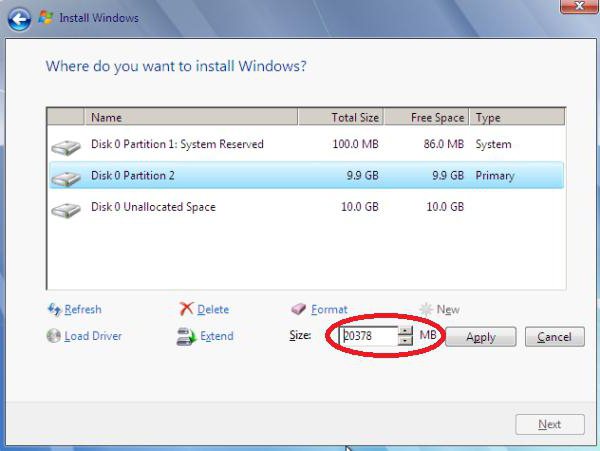
Fortunately, Windows 7, like all subsequent versions, has such a tool. First we look at the virtual partition D. We call up the menu and select the volume compression (the indicated size should slightly exceed the size of the distribution kit). Next, right-click on the menu and use the create command simple volume (without this, the system will not determine that this section is operational).
How to break the hard drive when installing Windows 7, it is clear. We proceed to the most crucial part.
System installation
Now we are directly interested in installing Window 7. Hard systems discs are such that they still do not see the distribution.
We start the Daemon Tools program and mount the image using the appropriate command, indicating the path to the saved file. We copy it to the newly created partition (unpacked image file).

Now we launch the EasyBCD application and press the add record button, after which we indicate the WinPE tab at the bottom, and then enter “ New volume", And in the path line we determine the location of the boot.wim file.

After the record is added, just restart the computer or laptop. In this case, the standard “seven” installation starts.
Installing Windows 7 Using the Command Line
Yet again, this option cannot be applied when the initial system has damage or errors. But in the case of recovery will do.
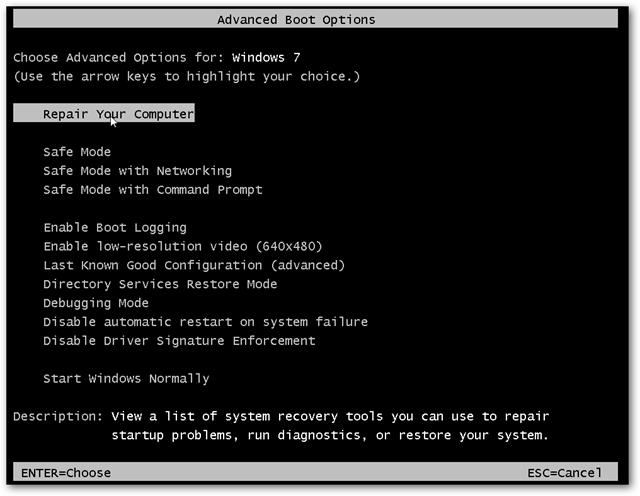
When Windows starts, press the F8 key ( standard method unlike Windows 10) and from the menu, select the troubleshooting line (the first in the list). In the additional parameters, specify the same thing, after which we use what is needed in the language selection window and proceed to the system recovery, where we select the command line.
In the console, we write two lines:
- X: \\\u003e windows \\ system32\u003e E;
- E:\u003e setup.exe
Do not be afraid to make a mistake. Drive letters in DOS and Windows do not match. In extreme cases, an error will simply be issued, after which it will be necessary to correct the corresponding symbol, but, as a rule, this is not required. Well, then the process starts, no different from the standard. Note that in this case, you do not even need to reboot the system.
Installation on top of any system using the BOOTICE utility
Now suppose we need another installation of Windows 7. There is a formatted hard drive. The catch is to create a bootable device as an HDD partition.
The BOOTICE utility is designed to emulate a sequel windows installation 7, creating and overwriting the boot sector (there is a bootmgr folder in the unpacked distribution for this).
To start the installation, you need to change the boot record MBR to GRUB4DOS. But here you need to consider one feature. The fact is that the utility requires the creation of the name of the boot loader manager of no more than five characters (letters).
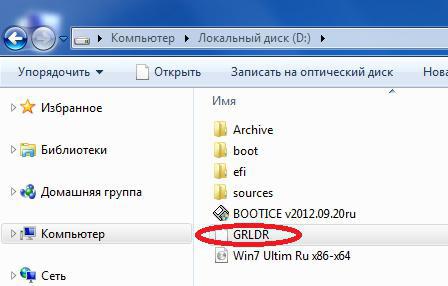
Rename the bootmgr file to GRLDR, and then run the utility itself. The menu is immediately visible new entry, so there we put a checkmark (destination disk), and then press the change installation button and select save to disk in the configuration. It remains only to reboot the device, after which the installation of Windows 7 will be activated. Installation from the hard drive will follow immediately. As a rule, problems should not arise.
Install Windows 7 on an external hard drive
But, despite all the nuances of installing the "seven" on the hard drive, some users try to install the system on removable media, in particular USB-HDD. What to say? This is fundamentally wrong!
![]()
The question is: why create problems for yourself out of the blue? From any USB device, loading is much slower than from a hard drive. The external drive itself (Winchester) is subjected to more severe physical impact and is not immune from the appearance of failures and errors. Nevertheless, “especially gifted” users will have to use (at least) a virtual machine. And many of these “geeks” have no idea what it is.
Of course, for the rest we can say that any virtual emulation, for example, using WMWare or the same built-in Hyper-V module can be carried out quite simply. But the matter is not limited to automatic settings. Here you have to set the appropriate system configuration parameters. And all those who say that with the operating system installed in it can be created in a couple of clicks and in five minutes are absolutely wrong. Nothing like this!
Possible errors and failures
Now the saddest thing. What to do if installation We do not consider issues of equipment failure in principle. External hard drive must be enabled in the BIOS, as well as boot priority from the main device.
If you have problems with file system, you can always use a command like sfc / scannow or chkntfs x / c (if as system disk section C is selected. Well, if the Winchester “sprinkled”, there's nothing to be done. Will have to change. Although ... Many experts advise first to use the program supposedly magnetizing surface of the disk, but it is difficult to believe in such a method.
On the other hand, when installing the system on an external drive, you can’t do without utilities like ImageX included with the Windows AIK package. In addition, the PWBoot module does not recognize Cyrillic characters at all, but it works like a command line. So is it worth it to do?
And that's not all! When the selection of several simultaneous installations begins, you will have to choose between the standard VHD container format and a conventional removable device. It is believed that the VHD format is read faster, but the problem of enabling this type of media is precisely the use of BIOS settings. And when switching from BIOS to UEFI (which is not always supported), there can be much more problems. However, for Windows 7, installation can be done using any of the above methods. But formatting partitions in most cases will fail.
Thus, the conclusion suggests itself that the simplest is the ideal solution. Using specific methods with the creation boot sectors the ordinary user will not use. It's obvious. But the system update technique looks much simpler, but it also has its drawbacks. In general, it is better to make a “clean” installation by first copying the necessary information to another medium.
Even non-advanced Windows users probably once heard that there are several ways to reinstall this operating system: using a DVD-ROM drive and a USB drive. These two options are now most common among users. However, there is one more that allows for a “clean” installation of Windows or updating it to more new version using the hard drive partition. It can help in cases where you don’t have a USB drive or a DVD disc on which you can burn an image of the operating system. If you are interested to know how to install windows 10 from a hard drive partitionWe recommend that you read this manual. Perhaps it will be useful to you in the future.
Make sure you have:
- ISO file with operating windows system 10.
- EasyBCD and UltraISO programs.
- At least 5 GB free space on the system partition.
Install Windows 10 from a hard drive
Interestingly, in this way you can install not only Windows 10, but also Windows 7, 8 and 8.1. If you have a desire to install any of these OSs, it will be enough for you to remove windows files 10, copy the files of your preferred system and specify the path to "boot.wim".
Greetings, friends.
Probably, every user of a computer or laptop was faced with a situation where he understands that it is time to reinstall the operating system. This is due to the appearance of difficulties in the work, frequent mistakes and other unpleasant moments. But what if you do not have a USB drive, a plastic disk for recording an image, or a drive refuses to work? Do not worry. Today I will tell you how to install Windows from a hard drive. Many do not even suspect that such tools exist at all.
It must be said right away that this option is suitable only for operating systems that are in working condition, since many movements will need to be done using the shell. That is, if you suddenly appeared blue screen - this method will not help.
In addition, it is worth noting that this guide should only be used for future installation of Windows 7 and higher versions. Moreover, it does not matter on which device the operation is performed. Therefore, Windows XP cannot be placed on a computer or laptop in this way. Since other mechanisms are used there.
For the procedure itself, we need several tools:
A program for working with images is usually DAEMON Tools. Personally, I generally use the built-in features of Win.
Utility Easybsd.
The image of the OS itself.
Step-by-step instruction( )
Important! It is advisable that up to this point your hard drive has already been divided into at least two partitions - for the system and files.
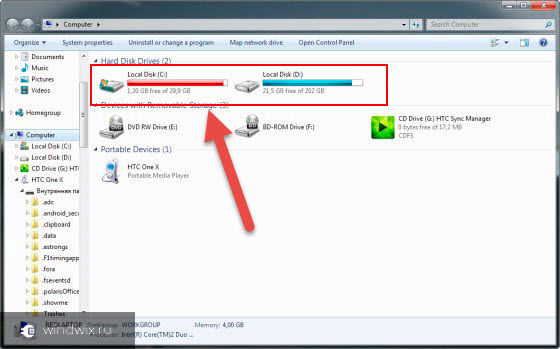
So, to install Windows 8 from the HDD, you need to perform a series of actions. First, create a separate section under setup files:
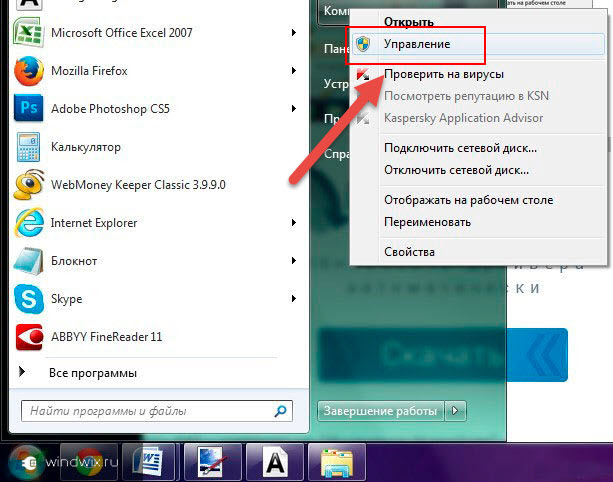
Now, to install Windows 10 or earlier, you need to properly prepare the files themselves:
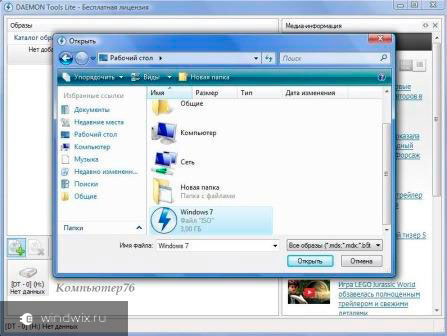
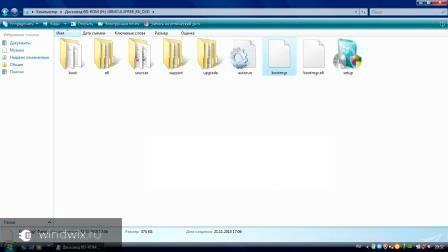
Now it is necessary to do so, the computer understood where to boot from. For this, the application is just needed EasyBCD. The sequence of actions is as follows:
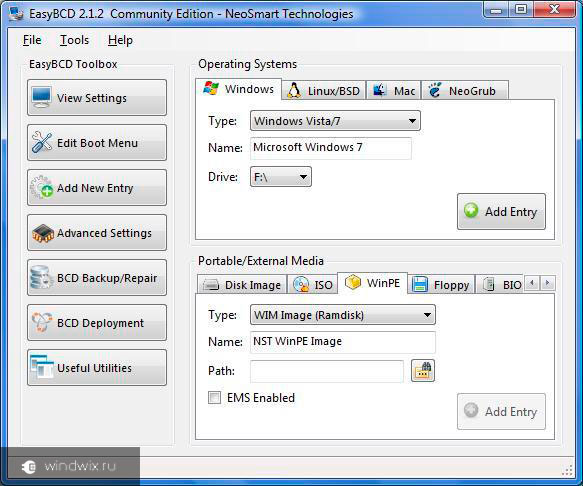
Suddenly, in some situation you don’t understand something, you can just watch the video:
If you select "", you will see a record appears or not. In your case, it should already be in place.

After the work done, close the application and restart the computer. As a result, a menu should appear in which users can select the desired system. Then indicate installation disk "". As a result, the standard OS installation procedure should start.
Bootice( )
The last chain of actions can be performed through Bootice. The program allows you not to create additional disk, but installs all of the available.
We do the following:
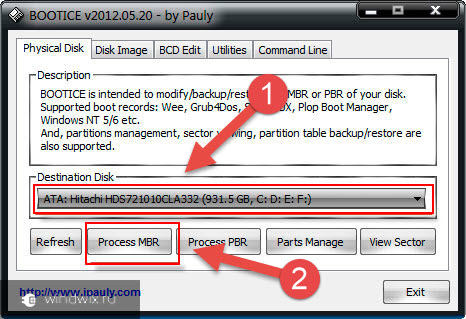
It is worth noting that it is not necessary to indicate exactly where the file is responsible for the correct loading of the system, since the application will find it itself.
Installation( )
This method does not require setting boot parameters via BIOS, as is the case with a plastic disk or USB drive. This approach is useful if suddenly your keyboard buttons do not work, allowing you to get to the right place.
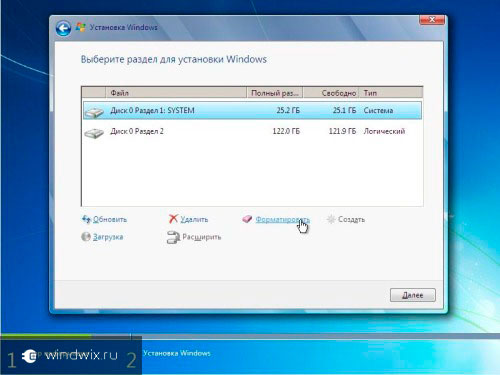
In general, regardless of the version of the future OS, the process is almost the same.
It is important to remember that before starting the process it is best to have one connected hard drive. This will simplify the process of selecting a partition. In addition, equipment will spend less resources, which in general will have a positive effect on performance. Therefore, you should not install the OS in such a way on another hard drive. The same can be said about the placement on the SSD. Of course, in the case of the correct execution of each action, problems should not arise. But even with the slightest error, it is possible to lose all the data on any of the partitions.
It is also worth noting that a similar procedure is possible with external hard drive. True, for this, you still need to run Win to set all the parameters. However, again, such procedures are not recommended, since by mistake you can simply delete the data.
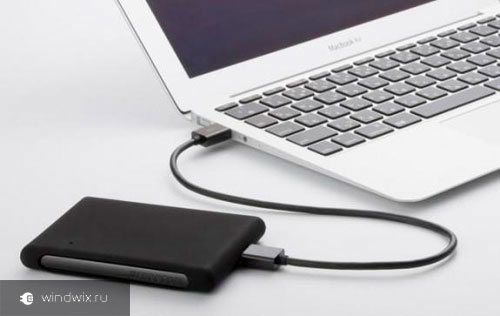
In the case of using a plug-in device, you can set the boot setting from the BIOS in the BIOS and simply place a new shell on the laptop or computer. True, for this you need to correctly write the OS to an external component. More details are available.
In any case, regardless of the method chosen, everyone can post a new one if the Windows is already on the computer.
Well, I hope the article helps you deal with problems on your device.
In general, I would like to recommend finding a compact portable USB device in advance (today they cost minimal money) and recording the correct system. Personally, I have three of them - for each latest version OS from Microsoft Corporation. Thus, I can insert a USB flash drive into the port at any second, and within two hours completely restore the computer’s performance, while having a brand new shell.
Good luck in your hard work! Subscribe and share the blog with others.
There are times when we have been using an optical disc with an operating system for a long time as a stand for hot tea. Winchester died the death of the brave. To purchase a flash drive or external hard drive have not yet earned. In general, the wife left us and the End of the World came. Situations are not pleasant and probably familiar to everyone. If you can somehow come to terms with the departure of your wife 🙂, then the need to reinstall the operating system right now and immediately, alas, is impossible.
What do we do? Consider installing a clean operating system from a primary hard drive. hDD drive, without using the gadgets described above.
Take a handful of flour. Stir with eggs and milk. Then a tablespoon of sugar and a pinch of salt ... Sorry friends 🙂, one eye squinting at the kitchen and therefore such hallucinations.
Of course, download the program from the official website of the developers (you can use WinRaR). And a free utility. Where to find ISO - Windows ImageI hope you do not need to be taught.
First we need to create a partition on the disk where we will copy the installation files for Windows 7, 8, 8.1. Alas with pigs (WindowsXP) this method does not work.
So let's get started. For this by shortcut My computer click right click → Manage → Disk Management.
We see all the information about the hard drive connected to the computer. It is desirable that the disk has already been divided into two parts. Getting to the division Drive (D :). Point to it with the mouse cursor and right-click. Choose → Compress Volume.
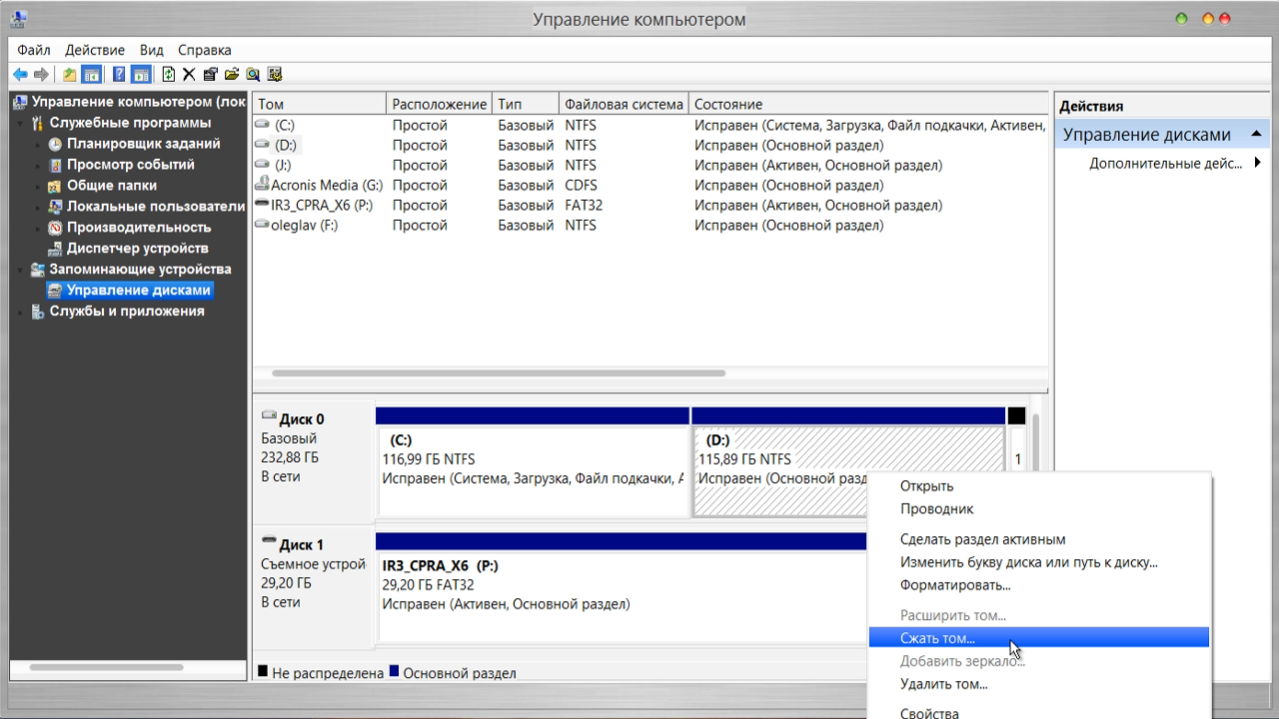
A request is made for a place to compress, what size can be compressed.

At the moment, the size of the compressible space is important to us (Mb :) It needs to be set not much larger than yours ISO Image. After the desired size has been set, press the button Squeeze. A short process and an unallocated space appears, we will transform it into a simple volume. Point the mouse at the unallocated space. Next, right-click and select in the drop-down menu Create a simple volume.

The Create Simple Volume Wizard launches. In all windows, click Further and in the very last window click Done. Our new volume has been successfully created.
Having sweated sweat from the face, we open the program DAEMON Tools Lite. Click on the button Add Image.

We remember where we have “hidden” on our computer ISO - operating system image. Successfully add an image to the program. In the image catalog, select it with the cursor and click on the button. To mount.

Close the program DAEMON Tools Lite. The installation image of the operating system is successfully mounted in a virtual drive (we look in the explorer). Copy all the content to ours new disc. In our case, this New Volume (E :).
We launch EasyBCD for adding boot record and start the installation of the system.
- Press the button Add a note
- Select the tab below Winpe
- In field Name: we write the same thing as on the new, just created section, in our case: New volume
- In field Way select file boot.wim from folder sources our created disc

- Push button Add
If it is not clear what I wrote, carefully watch the video (there all the actions are described clearly)
By clicking on the button Current settings You can check if a new record has appeared. EasyBCD You can close and restart the computer. An OS selection menu will appear in which we select our installation disk New volume. And the standard installation of the system will begin. Detailed installation system and all of the above, see the video. Yeah! This is a "zapara" many will think. And they will breathe a sigh of relief when their wife 🙂 returns. Now there is something to do, and not read these abstruse tips for reinstalling the operating system.
This method does not work on computers with BIOS UEFI. For cooler computers you can apply.
Help the victim of the capitalist cataclysm. Share the post in the social. networks:




